Medical Vehicle Markings
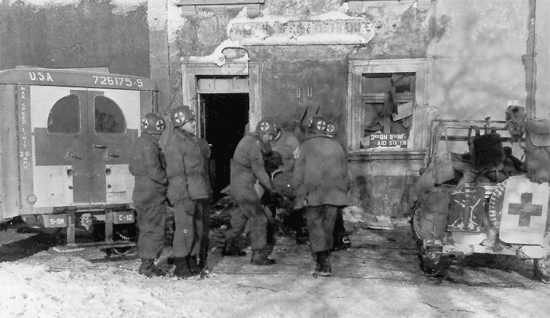
Temporary Aid Station, 3d Battalion, 11th Infantry Regiment, 5th Infantry Division, Diekirch area, Grand Duchy of Luxembourg, January 1945
Background:
Army Regulations No. 850-5 governed “Markings of Clothing, Equipment, Vehicles, and Property”. Specific paragraphs covered a variety of subjects, such as registration markings, unit markings, tactical markings, special markings, markings for animal-drawn vehicles, and markings for tractors and tanks.
The very first Army Regulations specifically dealing with “Markings of Vehicles” came out September 15, 1936, and covered prototype jeeps and early production Willys and Ford 1/4-Ton Trucks. Since most of the early Regulations do not really apply to E.T.O. WW2 Military Vehicles, we will restrict ourselves to Unit Markings and Special Markings related to vehicles used and/or operated by the Medical Department in this particular Theater. This implies that the present article will include elements from basic AR, including Changes dated August 5, 1942, October 15, 1942, March 25, 1944, and February 15, 1945.

Ambulance collecting point near the 8th Evacuation Hospital. The vehicles belong to the 551st Motor Ambulance Company (temporarily attached to the 161st Separate Medical Battalion), Italy, February 1945.
Important Remarks:
Unit identification markings will be applied to all motor and animal-drawn vehicles when assigned to and upon receipt by the organization or installation by which they are to be operated. These markings will be carried on the vehicle at all times while so assigned, but will be removed, or thoroughly obliterated when the vehicle is permanently transferred from the operating unit.
For unit markings, white lusterless, gasoline-soluble paint or paint as prescribed by the War Department will be used! It will be applied on an olive-drab background. Unit identification markings will be painted by means of stencils, if available, and if not, may be applied freehand at the discretion of Unit Commanders.
Unit identification symbols and numbers will consist of four groups in consecutive order, positioned from left to right, and separated by dashes (or hyphens) 1-inch long (not always applied).
The first two groups of unit markings will be effectively removed from all motor vehicles when leaving Home Stations for movement to Theaters of Operations, or Ports of Embarkation, and in the Theater of Operations when directed by the Theater Commanders.
Letters and numerals will be block type, or stenciled block type, of identical character style and dimensions as designed for traffic signs. Normal arrangement of the unit markings is a single line, usually broken, with hierarchic groups in consecutive order, from left to right (when facing the vehicle). If however, width of the surface does not permit all the markings to be placed in a single line, two lines may be used . In this case, the first and third groups should be placed in the top line, and the second and fourth groups in the lower one. In practice, this signifies that front bumper markings will be mostly 3 inches high, while those on the rear bumperettes will be applied in two superimposed lines of maximum 2 inches high (depending on the space available, and the number of symbols required).
Unit identification markings are usually placed on front and rear of the vehicle, and must be identical.
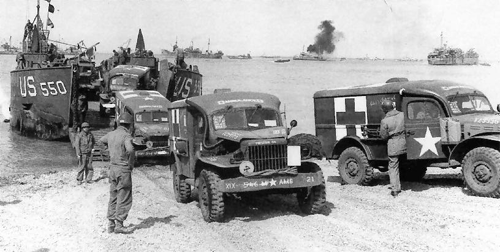
WC-54 Ambulances of the 546th Motor Ambulance Company, attached to XIX Army Corps, are disembarking from LCT 550, Normandy beach, France, June 1944.
Unit Identification Symbols:
Example – MRTC-26M D-14
First Group – this group of symbols designated the smallest appropriate unit; this could possibly identify, Army, Army Corps, Division, separate Commands, and any other large organizations.
MRTC > first group element, designating Medical Replacement Training Center (ZI organization – the “M” could also be represented by the branch insignia or Caduceus)
Second Group – this group designated separate Regiments, separate Brigades, separate Battalions, separate Companies, or any other similar units by appropriate number or symbol, followed by arm or service identification in accordance with official abbreviations. When intermediate levels of organization were missing, or when indicating Headquarters & Headquarters Companies, or special Companies of units identified in the first group, the second group would merely consist of the letter “X” as a filler. When indicating Brigades, the numeral was underlined.
MRTC-26M > Medical Replacement Training Center, 26th Medical Training Regiment
Third Group – designated Companies and or similar organizations by letters representing official abbreviations.
MRTC-26M D > Medical Replacement Training Center, 26th Medical Training Regiment, “Dog” Company
Fourth Group – designated the Serial Number of the vehicle in normal order of march within the organization to which it was assigned.
MRTC-26M D-14 > Medical Replacement Training Center, 26th Medical Training Regiment, “Dog” Company, 14th Vehicle
Other Examples of Unit Markings:
1A-1M DP-7 (First Army, 1st Medical Supply Depot, 7th Vehicle)
3A-587M AMB21 (Third Army, 587th Medical Ambulance Company, Motorized, 21st Vehicle)
II-40M A-10 (Second Army Corps, 40th Medical Battalion, A Company, 10th Vehicle)
2▲82R MED95 (2d Armored Division, 82d Armored Reconnaissance Battalion, Medical Detachment, 95th Vehicle)
82 A/B-X 307M-5 (82d Airborne Division, 307th Airborne Medical Company, 5th Vehicle)
91-316M CLR-6 (91st Infantry Division, 316th Medical Battalion, Medical Clearing Company, 6th Vehicle)
104-329E MED-1 (104th Infantry Division, 329th Combat Engineer Battalion, Medical Detachment, 1st Vehicle)
ASCZ28M GEN12 (Allied Supply and Communications Zone, 28th General Hospital, 12th Vehicle)
PBS-833M COLL-13 (Peninsular Base Section, 883d Medical Battalion, Medical Collecting Company, 13th Vehicle)
Other applicable 3d Group Medical Unit Markings:
CONV > Convalescent Hospital
EV and EVAC > Evacuation Hospital
FLD > Field Hospital
LAB > Medical Laboratory
M and MED > Medical Regiment, also Medical Detachment
SAN > Sanitary Company
STA > Station Hospital
SUR > Surgical Hospital
VET > Veterinary Company
Other units often cooperating or in touch with Medical Field Units, were designated by following groups of symbols:
AAFTCC – First Group, designating Army Air Forces, Troop Carrier Command (air evacuation and supply)
AGRC – First Group, designating Army Grave Registration Command
COMZ – First Group, designating Communications Zone, ETOUSA
NBS – First Group, designating Normandy Base Section
SOS – First Group, designating Services of Supply
G – Second Group, designating Chemical Warfare Service (decontamination)
X – Second Group, designating filler element
CON – Third Group, designating Construction Company
GR – Third Group, designating Graves Registration Company
MT – Third Group, designating Maintenance Company
REF – Third Group, designating Refrigeration Company
SV – Third Group, designating Service Company
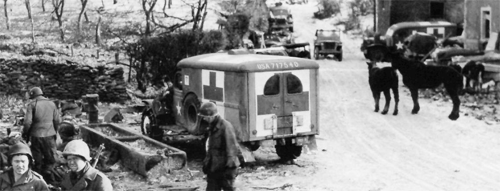
Village street in Foy (approx. 3 miles north of Bastogne), after its recapture by troopers of the 101st A/B Div. Ambulances stand ready to collect any wounded left behind. Picture taken 16 Jan 45.
Special Markings:
| WC-54 Field Ambulance | |
|---|---|
| 1941 – 1942 | 1944 – 1945 |
| Both sides – Red Cross 18 inches | 33 inches |
| Both sides – White Field 20 inches | 36 inches |
| Rear doors – 2 Red Cross 6 inches | 1 Red Cross 45 inches |
| Rear doors – 2 White Field 8 inches | 1 White Field 47 inches |
| Top – Red Cross 40 inches | 60 inches |
| Top – White Field 42 inches | 64 inches |
| Above windshield – 2 Red Cross 3 inches | 3 inches |
| Above windshield – 2 White Field 4 inches | 4 inches |
| Both sides – Caduceus 6 inches | 6 inches |
| Both sides – White Field 7 x 7 1/2 inches | 7 x 7 1/2 inches |
| Hood – White Star 25 inches | 25 inches |
| Both cab doors – White Stars 25 inches | 25 inches |
| Rear doors – White stars 6 inches | Nil |
| Top – White Star 18 inches | 36 inches |
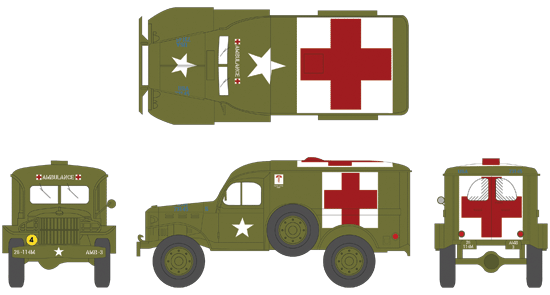
Illustration showing the standard markings of a Dodge WC54 Ambulance. Please click on the above image for a high resolution view, offering comments and captions.
Red Cross – There are two main possibilities to be considered – the early instructions dealing with special markings introduced end 1941, early 1942, and the amended regulations issued after fall of 1943.
Following Special Markings were introduced in December 1941, and could have been encountered on Ambulances, operating in the British Isles. They were still to be seen in the Mediterranean Theater of Operations in 1942 and 1943. Both sides of the body of a Medical Ambulance will be marked with a Geneva Convention Cross, bright red, on a snow-white square field of 20 inches, the cross to be 18 inches in the horizontal and vertical dimensions, and each limb to represent a 6-inch square. This symbol will be located in the center of the middle or advertising panel of the body, centered over the rear axle. A Geneva Red Cross on a snow-white field will be placed in the center of the vehicle’s top and on the outside. This Cross will be of such size, that its transverse arms will reach entirely across the top, this represents a white square field of 42 inches, with a Red Cross of about 40 inches by 13 inches.
On the visor, or directly above the windshield, will be marked in suitable size, in white letters, block style, the word AMBULANCE. On each side of the word AMBULANCE, will be placed a small bright Red Cross on a white field, or two small red Geneva Crosses may be placed on either side of the windshield in a location that will not interfere with the operator’s vision. Both small Red Crosses are 3 by 1 inches, on a white square field of 4 inches. The word AMBULANCE is 3 inches high, and about 22 inches long.
On the perpendicular center line of each of the rear doors, below the windows, will be placed a 6-inch bright red Geneva Cross on an 8-inch white field.
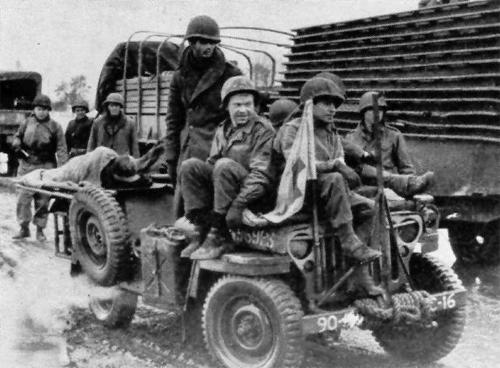
Casualties are being evacuated to the rear by a 90th Infantry Division Jeep Ambulance, the vehicle has been fitted with brackets for transport of litters.
After October 1943, new Regulations were issued, and dimensions and locations were amended. These would appear on newly-delivered Medical Ambulances.
Side markings now included red Geneva Crosses of 33 inches by 11 inches on a snow-white field of 36 inches. The vehicle top was covered by another Geneva Cross of 60 by 20 inches, positioned on a white field of 64 inches. The rear doors received more elaborate markings now displaying red Crosses of 45 by 15 inches on a white field of 47 inches.
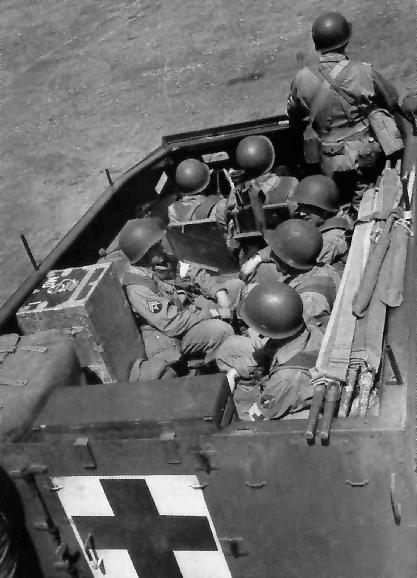
Personnel belonging to a Medical Detachment (attached to an Armored unit) are being transported in an M3A1 Scout Car.
Green Cross – Veterinary Ambulances only will be marked as prescribed for Medical Ambulances, except that the color of the Cross will be green. The markings of the Green Cross (please see above paragraph related to the Red Cross) will be placed as prescribed above, with the exception that the markings in the center of the top and in the rear will be omitted. The word AMBULANCE will be kept, but not the Caduceus branch insignia!
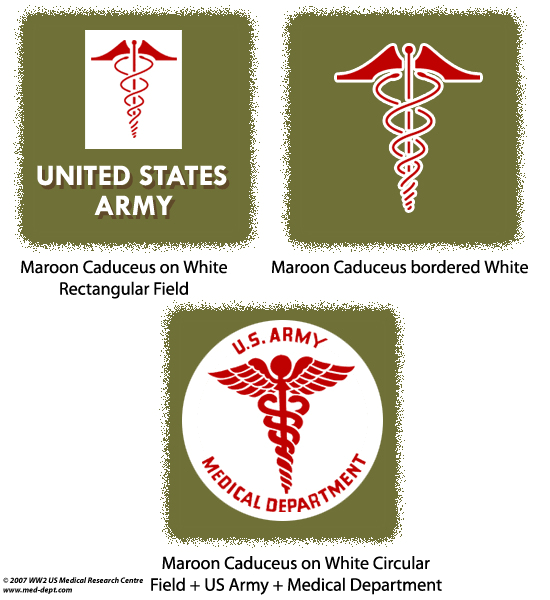
Illustration showing the evolution of Caduceus markings used on Ambulances during the Second World War.
Caduceus – early September 1936 and December 1941 instructions were as follows: a Caduceus, the official branch insignia of the Medical Department, maroon color, will be painted on both sides of the body of the Ambulance below the lower moulding and 7 inches to the rear of the front body as follows: a Caduceus 6 inches in height, on a white rectangular field of 7 by 7 ½ inches. In April 1942, an amendment now implied that the 6-inch high maroon Caduceus was to be outlined with a narrow white stripe (no longer placed on a white field), and painted with its anterior edge 7 inches from the rear edge of the vehicle’s side door. For those interested, another change was introduced in February 1945, whereby the Caduceus insignia was adapted to reflect a more cosmetic design; 7 ¾-inch high and 6 ½-inch wide, positioned on a 10-inch white circular field. Additional markings were to be added within the circle, such as U.S. ARMY (top) and MEDICAL DEPARTMENT (bottom). Drawing of the Caduceus will be furnished on request by the “Medical Department Equipment Laboratory”, Carlisle Barracks, Pennsylvania. 2 inches below this Caduceus in 1-inch white letters, block style, in two lines, will be painted the word:
UNITED STATES
ARMY
All paints used in marking Ambulances, will be of lusterless synthetic enamel of the proper colors prescribed above. All lettering executed in white, will be properly shaded to give depth. WC-54 (Dodge) Ambulances displaying the new Caduceus in a white circle are rarely seen in period-photographs. They would of course be applied on the new WC-64 (KD) Ambulances (supposed to replace the WC-54 vehicles, already classified as limited standard in April 1944).
Other Markings:
Standard War Department Registration Markings and Symbols were already applied in the factory, followed by those markings specific to the Medical Department. As standard practice (applicable to all United States Army vehicles), Unit Identification Markings, Weight Class Markings, and Tactical Markings, were applied by the units to which the Ambulances were assigned.
Vehicle Basic Color – painted at factory level, by the manufacturers, all vehicles were to be covered with olive-drab synthetic lusterless enamel.
War Department Registration – painted at factory level, by the manufacturers. Prior to January 1942, all vehicles received the standard symbols and numbers prescribed by the W.D., i.e., U.S.A. with prefix W, followed by a series of numbers always starting with digit 7 (reserved for Ambulances). Height was at first to be 4 inches and color was blue-drab lusterless enamel paint. Markings were applied by means of a stencil. The W prefix was dropped after January 1942. After August 1942, blue-drab was replaced by plain white, and height of markings reduced to 2 inches. As from January 1944, the letter S was added to the Registration Number to indicate that the vehicle had been suppressed to eliminate radio interference caused by its electrical system (over a range of 0.5 to 30 megacycles). The letter was to be as conspicuous as possible and followed design, size, and color of the registration number.

Illustration showing the various types of National Symbols used on US Military vehicles
National Symbol – the national symbol was specifically mentioned as from May 1942, i.e. a white five-pointed star was to be painted (with stencils) on all motor vehicles assigned to tactical units. AR however did not prescribe this marking for Ambulances. A list determined the size of the stars for each type of motor vehicle, large enough to take advantage of the available surface upon which it was to be painted. In the end, Ambulances received a 25-inch star on hood and cab doors, two 6-inch stars on both rear doors, and sometimes one 36-inch star on the rooftop (for enhanced aerial recognition). Whenever required by camouflage and concealment, this symbol could be covered by lusterless olive-drab gasoline solvent paint, camouflage nets, oil, or dirt, or simply be removed (painted with gasoline soluble paint).
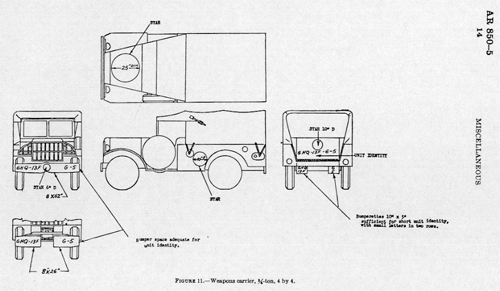
Example of location of white Stars for a Truck, Weapons Carrier, 3/4-Ton, 4 x 4, as per Army Regulations 850-5, dated 1942-1943.
Weight Class Markings – in 1943, following British habits, the War Department introduced a weight class system represented by a 6 or 8-inch round yellow disk, with 3-inch high black digit(s). The gross tonnage for the std. WC-54 Field Ambulance was 4. In February 1945, AR recommended that weight class should no longer be indicated on vehicles of less than 1 ½-Ton (unless directed otherwise by local Theater Commanders).
Tactical Markings – introduced in August 1942, these extra markings were to be painted with gasoline soluble paint or paints, and different colors were authorized. Unit Commanders were to prescribe the system to be used, the colors, and the forms (stripes, geometrical forms, names, or combined symbols). Such markings could include naming of individual vehicles. The special markings also included the less-known Bar Code Numbers (for POM, Preparation for Overseas Movement). For more information about these Unit Serial Numbers, please visit our Forum. It should be noted that individual characteristic designs such as caricatures, cartoons, coats of arms, and symbolic figures were not authorized!
Miscellaneous Markings – although AR 850-5 stated that markings not listed were prohibited, the rest of the vehicle having to be painted in olive-drab lusterless enamel, a whole series of miscellaneous markings and indications were added by driver and crew. These could be antifreeze (used for the radiator), additional left hand drive caution signs (for vehicles operated in the United Kingdom), mustard gas detection paint on the vehicle’s hood (indication of possible gas attack, also painted around stars), shipping stencils, maximum road speed, tire pressure, etc.
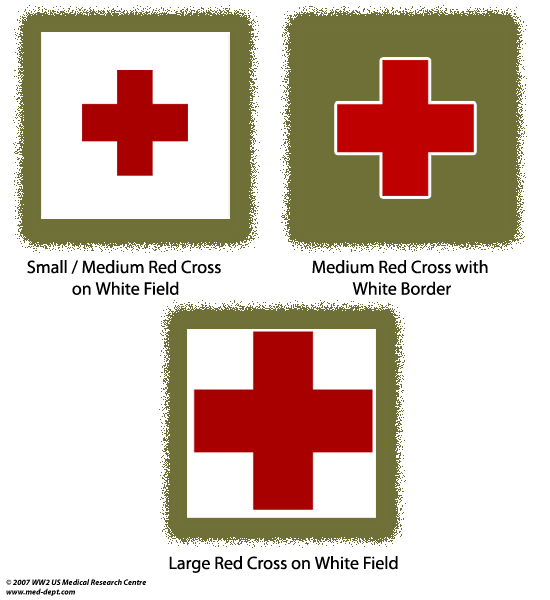
Illustration showing the various styles of Geneva Red Cross symbols as used on medical vehicles during WW2.
It should be noted that although compliance with the Army Regulations was fairly general, there were always deviations, caused by repainting, personnel ignoring requirements, or local instructions initiating non-regulation markings. Illustrations of these errors and/or deviations are frequently to be seen in vintage-photographs (they involve lack of space between symbols, absence of hyphen between letters and numerals, use of different sized characters, temporary markings applied with chalk, fourth group elements missing, lack of underlined Brigade elements, etc.)
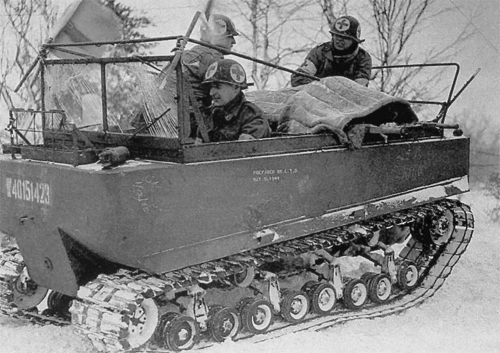
M-29 Weasel, being used as an Ambulance, negotiating ice and snow-covered roads, Bulge area, Belgium, January 1945.
Non-medical vehicles were often adorned with extra markings and symbols, in order to represent a ‘medical’ vehicle, and with the aim to be recognized by all parties, as being protected by the Geneva Convention; they would include jeeps, weapon carriers, tracked vehicles, amphibious vehicles, and different categories of trucks. It should be noted that, apart from possible Medical Unit Markings and extra medical ‘decoration’, they would keep their official registration numbers.
